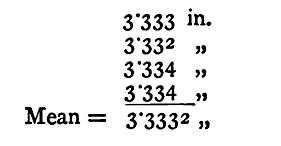| Practical Physics is a free textbook on basic laboratory physics. See the editorial for more information.... |

|

Home  Physical Arithmetic Physical Arithmetic  Mean of Observations Mean of Observations |
||||||






|
||||||
Mean of Observations
When all precautions have been taken, and all known errors corrected, there may still be some difference between different observations which can only arise from causes beyond the knowledge and control of the observer. We must, therefore, distinguish between errors due to known causes, which can be allowed for as corrections, or eliminated by repeating the observations under different conditions, and errors due to unknown causes, which are called 'accidental' errors. Thus, in the instance quoted, we know of no reason for taking 103.2543 as the mass of the body in preference to 103.2542. It is usual in such cases to take the arithmetic mean of the two observations, i.e. the number obtained by adding the two values together, and dividing by 2, as the nearest approximation to the true value.
q = (q1 + q2 + q3 + .... + qn)/n It is fair to suppose that, if we take a sufficient number of observations, some of them give results that are too large, others again results that are too small; and thus, by taking the mean of the observations as the true value, we approach more nearly than we can be sure of doing by adopting any single one of the observations. We have already mentioned that allowance must be made by means of a suitable correction for each constant error, that is for each known error whose effect upon the result may be calculated or eliminated by some suitable arrangement It is, of course, possible that the observer may have overlooked some source of constant error which will affect the final result. This must be very carefully guarded against, for taking the mean of a number of observations affords, in general, no assistance in the elimination of an error of that kind. The difference between the mean value and one of the observations is generally known technically as the 'error' of that observation. The theory of probabilities has been applied to the discussion of errors of observations1, and it has been shown that by taking the mean of n observations instead of a single observation, the so-called 'probable error' is reduced in the ratio of 1/sqrt(n). On this account alone it would be advisable to take several observations of each quantity measured in a physical experiment. By doing so, moreover, we not only get a result which is probably more accurate, but we find out to what extent the observations differ from each other, and thus obtain valuable information as to the degree of accuracy of which the method of observation is capable. Thus we have, on p. 54, four observations of a length, viz.
Taking the mean we are justified in assuming that the true length is accurately represented by 3.333 to the third decimal place, and we see that the different observations differ only by two units at most in that place. In performing the arithmetic for finding the mean of a number of observations, it is only necessary to add those columns in which differences occur - the last column of the example given above. Performing the addition on the other columns would be simply multiplying by 4, by which number we should have subsequently to divide. An example will make this clear. Find the mean of the following eight observations: - 56.231 56.275 56.243 56.255 56.256 56.267 56.273 56.266 Adding (8 x 56.2+)0.466 Mean 56.2582The figures introduced in the bracket would not appear in ordinary working. The separate observations of a measurement should be made quite independently, as actual mistakes in reading are always to be regarded as being within the bounds of possibility. Thus, for example, mistakes of a whole degree are sometimes made in reading a thermometer, and again in weighing, a beginner is not unlikely to mis-count the weights. Mistakes of this kind, which are to be very carefully distinguished from the 'errors of observation,' would probably be detected by an independent repetition of the observation. If there be good reason for thinking that an observation has been affected by an unknown error of this kind, the observation must be rejected altogether.
|
||||||
Home  Physical Arithmetic Physical Arithmetic  Mean of Observations Mean of Observations |
||||||
Last Update: 2011-03-27


